Istanbul | home
Istanbul
No one seems to know just how many people live in Istanbul. We have read and heard estimates that vary from 13 to 15 million. It's big, so big that in our 4 days there we only managed to see the most obvious places. Istanbul straddles the Bosphorus River, an important waterway linking the Black Sea with the Marmaris Sea and more importantly, the Aegean and the Mediterranean. The portion of Istanbul lying on the western shore of the Bosphorus is in Europe. The eastern portion of the city is in Asia.
Known as Byzantium until early in the 4th century AD, Istanbul has a long and complex ancient history of settlement dating back to about 800 BC and continuing through various occupations by Greek powers, Persia and later Rome. In 324 AD the Emperor Constantine moved the center of power here from Rome, revitalized the city and renamed it in his own honor. Modesty did not appear to be an issue with Roman Emperors. Constantinople was considered to be the dominant city in the western world for the next 900 years or so. Eventually, its power waned and after limping along for a while it was finally taken by the Turks in 1453. They promptly renamed it Istanbul and moved in with their own renovation program. Under their rule Istanbul regained its former status as a great city, but with an entirely different flavor. As Constantinople, it was a Christian city, the center of what was left of the Roman Empire. Under the Ottoman Turks, it was a Muslim city, ruled by the Sultans and at the center of their mysterious power, complete with lavish palaces, harems, great mosques, etc. What all this means to a modern visitor is the remnants of this history are everywhere and they provide four distinct areas for visitor focus:
1. Ruins of ancient Byzantium.
2. The legacy of Constantinople as the center of the Roman empire after 324 AD.
3. Visiting Topkapi Palace and other great Ottoman sites.
4. Immersion in modern Istanbul, itself a fascinating and sometimes overwhelming city.
We spent nearly all of our time in Sultanahmet, the section of town on the European side which was at the center of most of this history for over 2000 years. Sultanahmet today is a bustling area which contains many of the great sites of Istanbul. It is a fairly compact area that lends itself very well to exploration on foot. To see a map of the Sultanahmet section of Istanbul, click here. You might choose to print it while you're at it. While you are at the map site, you can also surf around and get all kinds of interesting information about Istanbul and other areas of Turkey. This is just one of several excellent web sites with a great deal of information of this subject. To return here, just click the back button on your browser or whatever.
The main attractions in Istanbul are:
We arrived in Istanbul on Wednesday afternoon, November 3. Our cab dropped us off in front of our charming small hotel, the Empress Zoe. The place was only half full and they upgraded us to a huge room. We looked out of the three windows just below the smiley face!
|
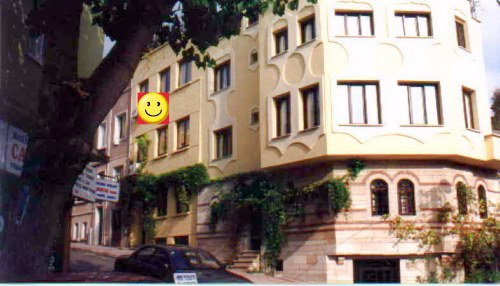
The Zoe is owned by an American and for the first time in Turkey we were in the company of our countrymen. Until this point we had seen very few Americans. Most other visitors to Turkey that we had encountered were German. We met two American couples here, one in their 20's and the other in their 60's, that we had breakfast and dinner with a couple of times. These traveling associations were welcome after three weeks of mostly each others' company. Now don't go reading anything into that statement! One of the great pleasures of this trip was our enjoyment of everything together.
|
For the balance of our first day in Istanbul we contented ourselves with walking around our Sultanahmet neighborhood, just taking it all in. We were very close to the Blue Mosque and the Hagia Sophia (which face each other across a beautiful park/square) as well as the Hippodrome, the site of the old Roman era stadium that is now a park with various interesting monuments. After cruising around, we eventually decided to splurge a bit and had dinner at one of the more famous places in town, the Sarnic. This restaurant is in a restored Roman era cistern, complete with perhaps a dozen old columns, barrel vaulted ceilings and illuminated entirely by candles. We have never eaten anywhere, in our lives, with more atmosphere, and the food and service were first rate. By Istanbul standards, the prices are scandalous which means that in the U.S. it was a moderately expensive place, but not horrible.
Here's a photo gallery of some of what we saw in Istanbul:
|
The Blue Mosque, left and the Hagia Sophia
|
|
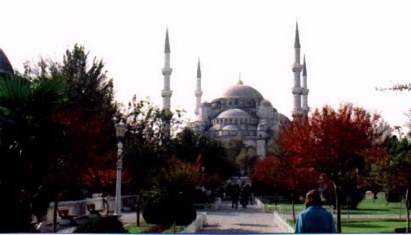 |
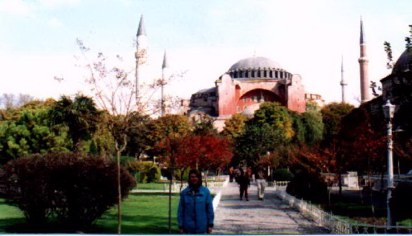 |
Inside the Harem, Topkapi Palace. 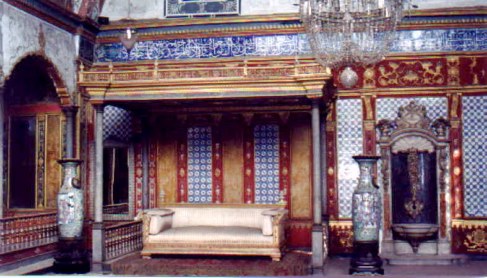

We also visited the Yerebatan Cistern, a subterranean Roman cistern that has to be seen to be believed. This place is enormous, containing 336 columns like you see here, all built for water storage in the 6th century. It lay forgotten for hundreds of years and was eventually rediscovered and restored. This lies directly under a large section of Sultanahmet, a startling fact which is certainly not apparent when one is walking around the streets above. In addition to the phenomenon of the cistern itself, the base of two of the columns are large Medusa heads. Like most of the pillars, these were taken from some ancient site elsewhere in Turkey for use in this 6th century construction project. There is still about a foot of water in this place, so there are elevated boardwalks which permit you to stroll around. In the picture you can see the fine work at the top of the pillars and sort of see some barrel vaulting. All 336 columns were similarly constructed! We stumbled across the entrance to the cistern without being aware of its existence. We later read about it in our book.
|
Photos of the Yerebatan Cistern
|
||
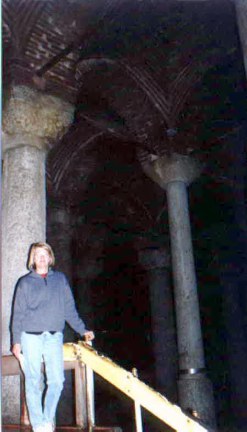 |
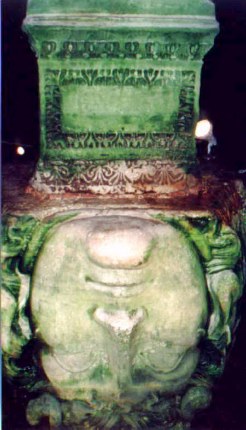 |
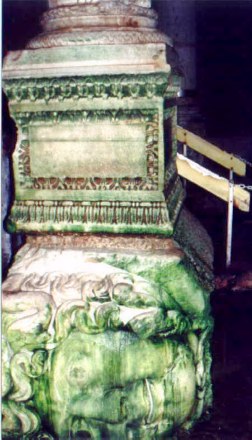 |
Yep, these Medusa pictures are right side up. I guess the Romans were worried that if they mounted her upright, her gaze might turn them to stone!
The use of stone from older sites was very common. It was far easier for a Roman to take cut stone from a pagan temple, which they didn't want to honor anyway, than it was to start from scratch. This practice resulted in the construction of most of the fine Roman ruins we saw, as well as this cistern, at the expense of some glorious older structures, now defunct.
The Hagia Sophia is noted for its mosaics. Most of these date back to about the 10th century or so. When the Ottomans took over in the 15th century, they converted the Hagia Sophia into a mosque and plastered over the mosaics. This was a much more enlightened approach than destroying them, and it is now possible to view some restored mosaics on the walls of the great church:
|
Jesus, Mary and St. John
|
Jesus with the Empress Zoe and Emperor Constantine IX. Empress Zoe had the man's face in this 11th century mosaic redone three times because she kept outliving her husbands!
|
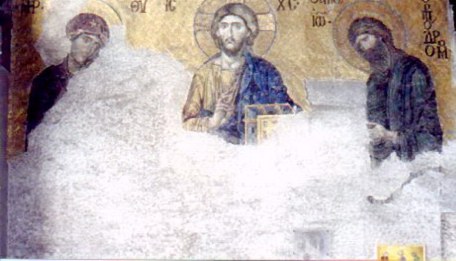 |
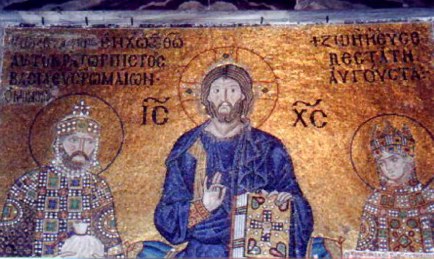 |
Of course, these images consist of thousands of tiny ceramic tiles, just one more astounding achievement of man. We saw many fine mosaics in Italy as well, but these are much older.
The area around the Grand Bazaar had more people in it than we've ever seen before. This was particularly true on Saturday when the locals turned out in force. It's difficult to explain how fascinating we found this facet of Istanbul. The energy of the crowd, the foreignness of it all, the narrow streets jammed with people, sellers, trucks, handcarts and merchandise of all kinds, the last often laid out on the pavement on a piece of cardboard. This activity extended well outside the covered primary area of the Grand Bazaar. The entire area between the Galata Bridge over the Golden Horn and the Grand Bazaar was generally a sea of humanity. In spite of the congestion, there did not appear to be much tension. Occasionally a shop owner would yell at someone trying to get a truck through against seemingly impossible odds, but for the most part everyone got along fine.
|
Istanbul Crowds
|
|
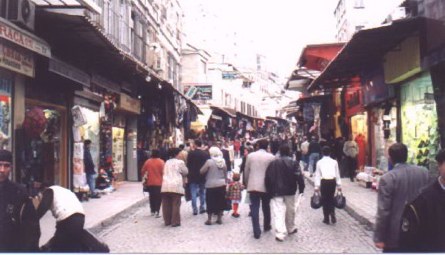 |
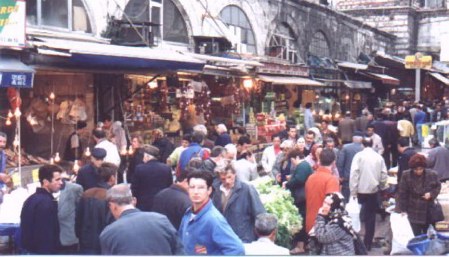 |
Wares in the kitchenware district
|
Traffic jam in market district
|
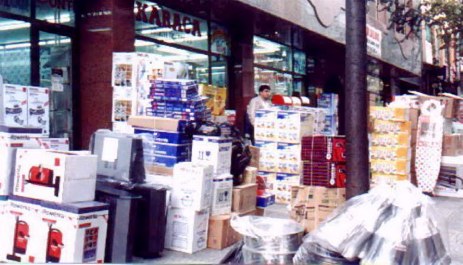 |
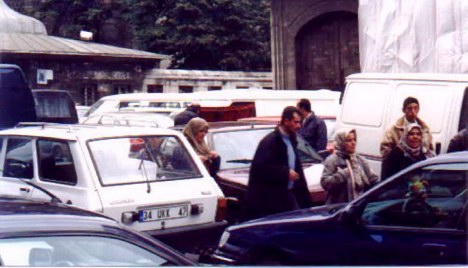 |
These pictures don't do the congestion justice. At one point we chose to detour around an entire neighborhood
to avoid the impossible task of walking through.